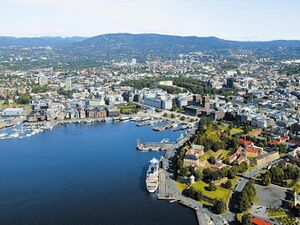Heersduik
| Heersduik | |
 View over Heersduik from the north | |
| Nicknames | De Dijk, Dutchland |
| Country | File:Flag vyv.png Vyvland |
| Province | File:Flag-east.png Helland |
| Municipality | Heersduik |
| Type | City |
| Mayor | Nicolaas Jong |
| Constituency MPs | 7 |
| Population | 672,119 (2012) |
| Area | 296km2 (114mi2) |
| Density | 2,271/km2 (5,896/mi2) |
| Elevation | 12m |
| Demonym | Duiker |
| Time zone | UTC -2 |
| Postcode | D0000-D1499 |
| Phone code | 1435 (HDK) |
| Website | http://www.heersduik-stad.gov.vy |
Heersduik is a city on the eastern coast of Vyvland, and the centre of the Dutch-speaking Helland province. It is also a major port, with the Vyvlander Navy's largest base (Royal Schierei) stationed in its southeastern suburbs, in which 1,100 people are employed. It is the seventh-largest Vyvlander city by both population within the city limits and within the urban area, with over 670,000 inhabitants, and is the largest city on Vyvland's east coast.
Traditionally, Heersduik has seen itself as isolated from the rest of Vyvland, due to its geographical and cultural isolation and ignoration by the former North Vyvlander government in Vlud. Thus, the city has become a major cultural centre and tourist destination for other Vyvlanders. However, the region's isolation has led to separatist and autonomy movements; 52% of the Provincial Diet's seats are represented by Helland-only parties. The current city council is run by a social democratic coalition between the Dutch People's Party and nationwide Socialist Party.
History
The city was founded by Dutch settlers on the site of an existing yet abandoned Vyvlander settlement in approximately 1000 AD. It is thought the name originated from 'Heers Dijk', or Lord's dike, referring to the steep-sided valley running inland from the city's bay, in which the city was built. The city and the Helland area surrounding it remained independent until the 1300s and then autonomous for hundreds of years afterwards as a trading port. This meant that the city was not obliged to pay taxes to the King of Vyvland and therefore was able to keep its vast trading wealth within the city, leading to the construction of ornate palaces and buildings. However, the eighteenth-century monarchy of Vyvland began to assert greater authority over the city, establishing a naval base there in 1763, which grew to be one of the largest bases in Vyvland.
Seen as backward and uncivilised due to the linguistic minority, many upper- and middle-class citizens of Heersduik began to speak Vyvlander in the mid-nineteenth century, leaving the local Helish dialect of Dutch stigmatised until well into the twentieth century. However, reforms under Gunfre Smef-Hoyg in the early 1970s elevated the status of the language, and it thus began to reverse its previous terminal decline. The following decades saw an increase in migrant population in the city, especially including monarchists fleeing from Unolia during and after the Unolian Civil War. In 2013, a Unolian fighter jet bombed the naval base, leaving 33 dead, including 3 civilians, during the Roubao conflict. Dozens more were injured.
Twin towns
See also: List of twinned cities in Vyvland Heersduik is twinned with the following cities:
Heersduik's status as a naval port is reflected in its twinning with Nordport, home of the Geadish Navy, and Kolborg, Semarland's main port.